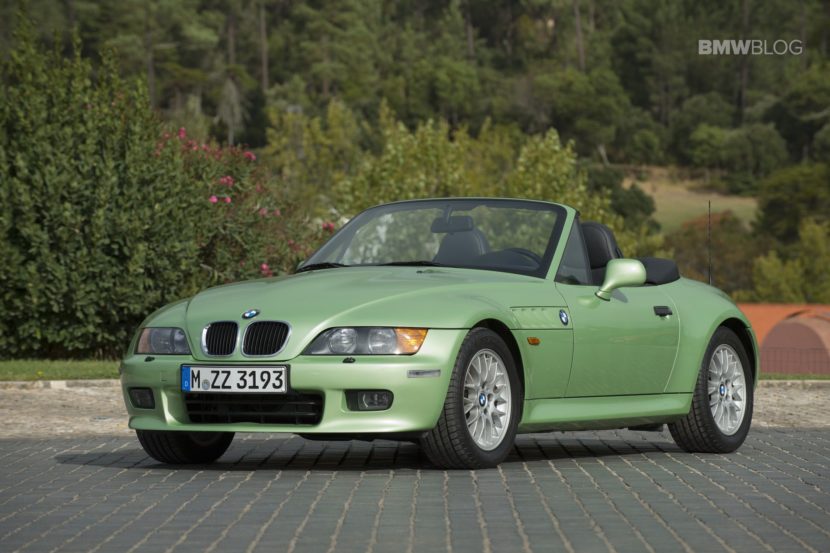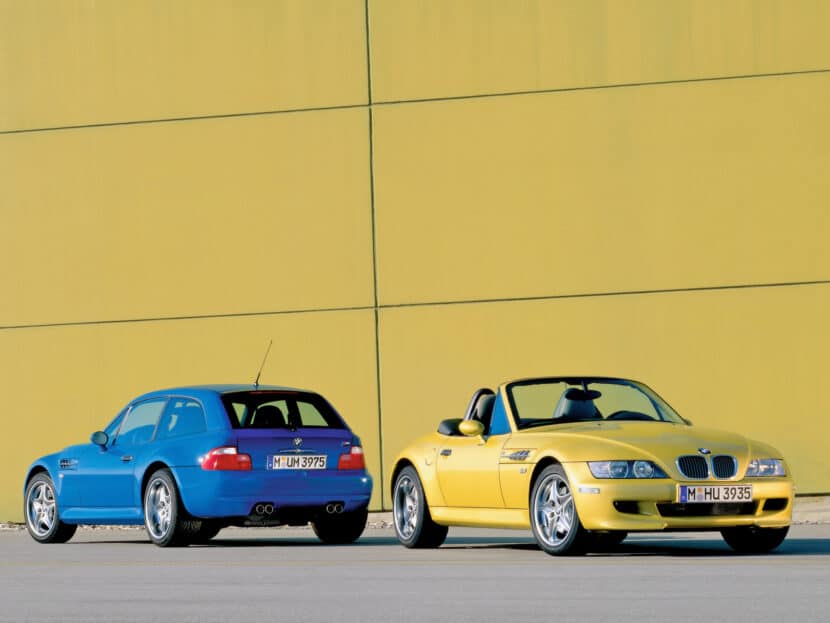Thirty years ago, BMW took a chance. In an era dominated by sedans and growing interest in SUVs, it built a two-seat, rear-wheel-drive roadster. Small, simple, and built in South Carolina, the BMW Z3 arrived in 1995 with the goal of reviving the spirit of classic open-top driving. Today, it’s remembered as one of the brand’s most significant models of the 1990s—both culturally and strategically.
Launched in 1995, Built in America
The Z3 was officially unveiled in June 1995 and went into production that September at BMW’s then-new Spartanburg plant in South Carolina. It was the first BMW model built exclusively outside of Germany, and it helped establish the U.S. factory as a core part of BMW’s global manufacturing footprint. Under the skin, the Z3 used the E36 3 Series platform, with early models featuring either a 1.8-liter or 1.9-liter four-cylinder engine. A five-speed manual was standard, and the car’s layout followed traditional roadster proportions: long hood, short rear deck, and seating pushed far back near the rear axle.
A Designer’s Touch with Heritage Ties
Designed by Joji Nagashima, the Z3 borrowed several styling cues from the past—most notably the side gills and roundel placement inspired by the 1950s BMW 507. Yet it wasn’t retro for the sake of nostalgia. The Z3 was very much a 1990s product, from its interior materials to the slightly bulbous tail. Still, the proportions were spot-on, and the overall shape aged well. It was one of the few BMWs of the era that prioritized form over practicality.
Global Fame via James Bond


The Z3 received an early boost in visibility when it appeared in the 1995 James Bond film GoldenEye. Pierce Brosnan’s Bond drove a blue Z3 fitted with fictional gadgets—a decision that marked the first time 007 drove a non-British car in an official film. BMW capitalized on the exposure by building a limited run of “James Bond Edition” models. Only 100 units were made for the U.S. market, each featuring unique badging and trim.
From Commuter Car to M Car
By 1997, the Z3 lineup expanded to include straight-six engines. The 2.8-liter inline-six (M52B28) brought 193 horsepower and a noticeable bump in performance. That same year, BMW introduced the M Roadster, powered by the 3.2-liter S50 engine from the European-spec M3 (and later the S52 and S54 in North America and post-facelift cars). It featured unique styling, including wider fenders, quad exhaust tips, and M-specific wheels and trim. Output ranged from 240 hp in early U.S. models to 321 hp and eventually 325 hp in later European and U.S. S54-powered versions.
The M Roadster was a serious driver’s car. It also included upgraded brakes, limited-slip differential, and stiffer suspension—far more than a cosmetic performance trim.
The Z3 Coupe: Rare and Polarizing
In 1998, BMW introduced a fixed-roof version of the Z3, known internally as the E36/8 and publicly as the Z3 Coupe. The shooting brake-style design was unusual even then, with critics and fans split on its appearance. Over time, it found favor among enthusiasts, earning nicknames like “clown shoe” and gaining appreciation for its rigidity and driver-focused dynamics.
The Z3 Coupe was offered exclusively with inline-six engines, including 2.8-liter, 3.0-liter, and M variants. Just under 18,000 units were produced globally, making it one of the rarer BMWs of its era. Today, Z3 M Coupes—especially those with the S54 engine—are in high demand among collectors.
Special Editions and Experiments
BMW experimented extensively with the Z3 platform. BMW M engineers once built a one-off Z3 M V12, fitting a 5.4-liter, 326-hp V12 from the 7 Series under the hood. Though never intended for production, it demonstrated the car’s versatility.
A number of special edition Z3 models also rolled out during its life cycle. These included the Sport Edition (with lowered suspension, M details, and 17-inch wheels), British Traditional, Dakar, and Kyalami packages, many created through BMW Individual. A Millennium Edition Z3 Coupe was also produced as a contest prize for a German car magazine.
End of the Line in 2002
Production of the Z3 ended on June 28, 2002, with a total of 297,087 units built—more than any prior BMW roadster. The final unit is now on display at BMW’s Spartanburg museum. The Z3 was succeeded by the E85 Z4, which introduced a more modern take on the roadster formula with increased rigidity, interior upgrades, and updated tech.
A Legacy That Lasts
Three decades later, the Z3 remains one of the most recognizable BMWs of the modern era. It wasn’t the fastest or most advanced car BMW ever made. But it captured something the brand hadn’t fully delivered since the days of the 507—a sense of freedom, simplicity, and focus on pure driving.
The Z3’s mix of analog feedback, clean styling, and now-rare proportions have helped it transition from a fashionable 1990s experiment into a legitimate modern classic. Whether it’s an early four-cylinder roadster or a late-model M Coupe, the Z3 stands as a reminder of a time when BMW was willing to build a car just because it was fun.
BMW Z3 Model & Engine Specifications (1995–2002) – Four-Cylinder Models
| Model | Engine Code | Displacement | Power | Torque | Years |
|---|---|---|---|---|---|
| Z3 1.8i | M43B18 | 1.8 L | 115 hp (85 kW) @ 5,500 rpm | 168 Nm @ 3,900 rpm | 1995–1999 |
| Z3 1.9i (early) | M44B19 | 1.9 L | 140 hp (103 kW) @ 6,000 rpm | 180 Nm @ 4,300 rpm | 1996–1999 |
| Z3 1.9i (facelift) | M43B19 | 1.9 L | 117 hp (86 kW) @ 5,500 rpm | 180 Nm @ 3,900 rpm | 1999–2000 |
| Note: The M44 1.9i used DOHC and offered better performance than the post-facelift M43B19, which was SOHC. | |||||
BMW Z3 Model & Engine Specifications (1999–2002) – Six-Cylinder Models
| Model | Engine Code | Displacement | Power | Torque | Years |
|---|---|---|---|---|---|
| Z3 2.0i | M52TUB20 | 2.0 L | 150 hp (110 kW) @ 6,000 rpm | 190 Nm @ 3,500 rpm | 1999–2000 |
| Z3 2.2i | M54B22 | 2.2 L | 170 hp (125 kW) @ 6,100 rpm | 210 Nm @ 3,500 rpm | 2000–2002 |
| Z3 2.5i | M54B25 | 2.5 L | 184 hp (135 kW) @ 6,000 rpm | 237 Nm @ 3,500 rpm | 2000–2002 |
| Z3 2.8i | M52B28 | 2.8 L | 193 hp (142 kW) @ 5,300 rpm | 280 Nm @ 3,950 rpm | 1996–2000 |
| Z3 3.0i | M54B30 | 3.0 L | 231 hp (170 kW) @ 5,900 rpm | 300 Nm @ 3,500 rpm | 2000–2002 |
BMW M Roadster / M Coupe (1997–2002)
| Model | Engine Code | Displacement | Power | Torque | Region | Years |
|---|---|---|---|---|---|---|
| M Roadster / Coupe | S50B32 | 3.2 L | 321 hp (236 kW) @ 7,400 rpm | 350 Nm @ 3,250 rpm | EU | 1997–2000 |
| M Roadster / Coupe | S52B32 | 3.2 L | 240 hp (179 kW) @ 6,000 rpm | 320 Nm @ 3,800 rpm | US | 1998–2000 |
| M Roadster / Coupe | S54B32 | 3.2 L | 325 hp (239 kW) @ 7,400 rpm | 355 Nm @ 4,900 rpm | EU/US | 2001–2002 |
Factory Wheel Designs by Model
| Wheel Style | Diameter | Design Name | Notes |
|---|---|---|---|
| Style 35 | 16” | Classic Star-Spoke | Common on early 1.9i |
| Style 42 | BBS Split-Spoke | BBS Split-Spoke | Available on Sport Edition |
| Style 55 | 16” | Contour Styling | Optional on 2.8i |
| Style 78 | 17” | M Double-Spoke II | Fitted to M Roadsters/Coupes |
| Style 40 | 17” | M RoadStar | Standard on all M models |
| Style 32 | 16”–17” | Radial Spoke | Optional on higher trims |
Special and Limited Edition Z3 Models
James Bond Edition (1996)
- Built to celebrate GoldenEye
- Exterior color: Atlanta Blue Metallic
- Beige leather interior, wood trim, chrome accents
- Special badging and 007 documentation
- 100 units built (U.S. only)
British Traditional Edition
- British Racing Green exterior
- Tan leather seats with piping
- Chrome exterior accents
- Wooden interior trim
- Limited availability in Europe
Sport Edition (Europe-only, ~1999)
- Lowered suspension (–15 mm)
- Rear limited-slip differential (25%)
- Style 42 or Style 78 17-inch wheels
- M steering wheel and shift knob
- Blacked-out interior trim
BMW Individual Colors
Offered various one-off Z3s and packages:
- Dakar Yellow II
- Estoril Blue
- Imola Red
- Velvet Blue with matching interior
- Two-tone Nappa leather interiors (Kyalami Edition)
- Contrasting color seat piping and stitching
- BMW Individual dash plaque
Millennium Edition (1999)
- Unique Z3 Coupe built as a magazine giveaway
- One-off design commissioned by Auto Bild
- Featured exclusive upholstery and dash plaque
MotoGP Safety Cars (1998–1999)
- Z3 M Coupes used as MotoGP safety cars
- Painted in Titanium Silver with safety livery
- Light bar and roll cage installed
- Not sold to the public
Z3 M V12 Prototype (See it here)
- Engine: M73B54 5.4-liter V12 from 750i
- 326 hp
- One-off built for engineering study
- Required major structural changes to the engine bay
- Never considered for production











